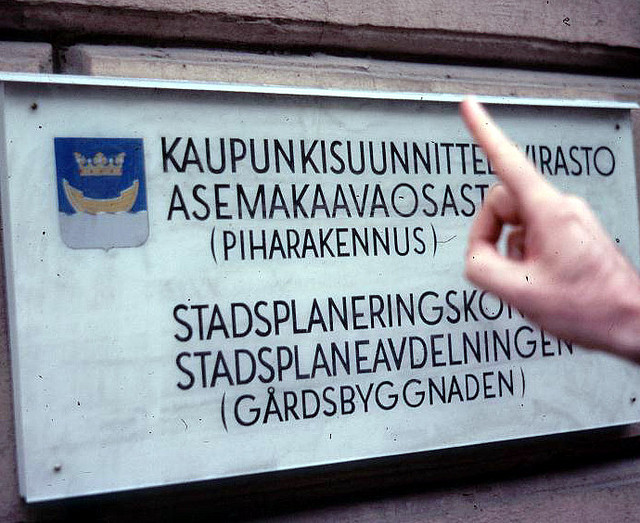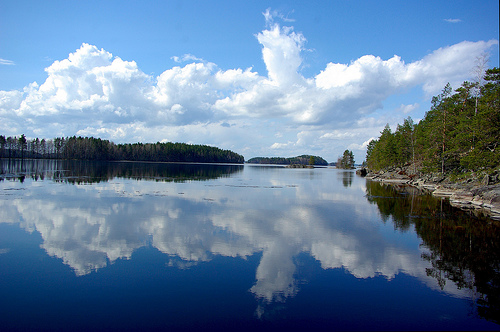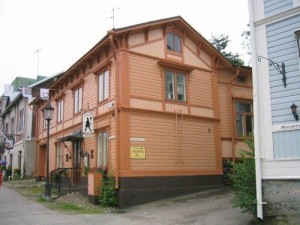A Quick Introduction to Finland
Finland (Suomi in Finnish) is one of the northernmost countries in the world and it’s an awesome place to visit! This article provides you with a very quick introduction to Finland – you can read more by browsing through this website.

Finland
Outstanding wilderness areas, forests populated by wolves and bears, lakeside cottages, whitewater canoeing and arctic skiing in Lapland, modern towns and cities, the Northern Lights, beer terraces, great music and film festivals. As a country to visit, Finland offers way more than the average European destination.
Finland is also one of the largest countries in Europe and Lapland, which makes up a full one third of Finland, is north of the Arctic Circle. Culturally and politically, Finland is part of Scandinavia and this is reflected in the country’s culture, high standard of living,education system (one of the best in the world), its avant-garde design (and in its high taxes).
Geographically somewhat remote (but still easy to get to from pretty much anywhere in the world except New Zealand & Australia), Finland doesn’t attract the same number of visitors that travel to Denmark, Norway and Sweden – and as Finland is one of the least densely populated countries of Europe ( With some 5,2 million inhabitants, there are only 15.7 people per square mile), you’re not going to feel too crowded the way you do in so many other European countries.
That said, once you get to Finland, traveling within the country is straightforward. Public transport runs on time and it’s clean and efficient. There are Tourist Offices everywhere and they really are there to help you. Roads are good and well signposted, maps are accurate and its easy to drive yourself around (although in winter, if you’re not used to driving in snow conditions, you may want to take a little extra care).
Pretty much every Finn speaks at least a bit of English so it’s unlikely you’ll need to haul out your phrase book. With regard to language, Finnish is radically different from almost all other European languages (Hungarian is the only language in Europe that’s related to Finnish – and the relationship is distant both in time and geography).

OK, Finland IS bilingual – signs are in Finnish & Swedish
Finnish is probably about as difficult to learn as Chinese and the grammar is, to be blunt, difficult to learn. It’s not an Indo-European language and there’s no relationship to Russian, Swedish, Norwegian or Danish. However, Finland IS officially bilingual (the other language is Swedish) and maps and street signs are usually in both languages. The saving grace for english-speaking visitors to the country is that most Finns speak, and are reasonably fluent, in English. There are of course some good Finnish phrase books and grammar’s available for those who are willing and eager to “give it a go”.
Finns themselves are often stereotyped as a bit quiet and reserved and not at all talkative. This is to a certain extent true, but Finns are also warm, friendly and hospitable and they are almost always interested in knowing what visitors to the country think of Finland and its people. Finns are also very honest people – Finland ranks up there with New Zealand as one of the most honest and least corrupt (in a financial / legal / contractual sense) countries on this planet. Nice thing to know when you’re planning a holiday!
When to visit?
The Finnish climate can be somewhat extreme in winter to those not used to cold and snow. The coldest months are January and February, with snow falling in southern Finland in December (and sometimes earlier). Spring arrives in May and the summers are short but pleasantly warm. For more on the climate, see Finnish Weather.
The tourist season in southern Finland is generally regarded as being from the start of June through to late August. This is pretty much the “summer season” and its when all the summer attractions, summer accommodation, many museums and places such as summer restaurants are open. The larger lakes see cruise boats and ferries at work and there are many summer festivals at different places around the country. Finland is also the Land of the Midnight Sun, especially the further north you go, and summer days are long, with short to non-existent nights. July and August is also the time when many Finns take their summer holidays – towns and cities can be quite – and for Helsinki Hotels this is the low season, so the cost of accommodation is lower than might otherwise be expected.
Lapland and the north are not the same as Southern Finland. In July, the mosquitoes and other biting insects can be unbearable. They’re not as bad in August and in September the north is truly beautiful as autumn turns the leaves to many different colours (for North Americans, similarly to Fall in New England and Quebec). Through the winter months, the skiing, both downhill and cross-country. is superb. You can also enjoy such outdoor adventures as dog-sledding, reindeer racing. visiting the home of Santa Claus and viewing the Northern Lights (aurora borealis). Lapland is a popular destination in winter, with charter flights bringing in visitors direct – but for all that, it’s still uncrowded.
Currency and Costs
Like many other countries within Europe, Finland is now on the Euro, the old Finnish Markka having vanished into the dustbin of history (although for how long, given what’s been happening with the Euro of late, is a moot point). Anyhow, it’s the Euro for now, so that’s how all costs are identified. Exchange rates fluctuate, so take this as a guide, although being online I’ll endeavor to keep it up to date.
For the current exchange rates from the Euro to other currencies, follow this link: Yahoo Finance Currency Convertor
Speaking of Finland’s Geography

- Lake Saimaa – Finland’s largest lake
Finland stretches 700 miles in length and at its widest, the country is 335 miles across. There’s 682 miles of Baltic coastline and its borders are equally long. There’s a 363 mile long border with Sweden in the west, 444 miles of border shared with Norway in the north and a lengthy 787 mile border with Russia. In the south Finland is bounded by the Gulf of Finland while to west the boundary is the Gulf of Bothnia – both arms of the Baltic Sea. An island Archipelago (Finland also has thousands of islands) stretches down the length of the Gulf of Finland and out into the Baltic towards Sweden.
Finland was shaped by the glacial ice-sheets of the last Ice Age and has a mammoth 187, 888 lakes – 10% of the country’s area! Finland’s largest lake, (in the aptly named Lakeland region) is the fourth largest in Europe.
Most of the lakes are actually quite shallow, averaging 24 feet in depth (that’s still well over your head when swimming). The countryside itself is generally low-lying, with flat to rolling plains interspersed with lakes and low hills. Lapland has a rather more rugged landscape with the highest point being Halti at 4,344 feet above sea level. But to the visitor flying in, especially in winter, the main impression you’ll get as you look out from the aircraft is that there are rather a lot of trees…
And speaking of flying in……
Most foreign visitors to Finland who fly in arrive at Helsinki-Vantaa airport (HEL). This is a rather pleasant international airport about 12 miles (a 30 minute bus ride) from the centre of Helsinki. Other international airports include Tampere (TMP), Turku (TKU), Oulu (OUL), Vaasa (VAA) and Rovaniemi (RVN), the transport hub of Lapland. There are good flight connections to Finland from all over the world. Finnair, the Finnish national carrier, and SAS (the Scandinavian airline) have scheduled flights to Helsinki from most major cities in Europe, as well as from New York, San Francisco, Cairo, Bangkok, Hong Kong, Singapore, Beijing, Shanghai, Guangzhou, Osaka and Tokyo. There are several nonstop flights daily from Stockholm to Turku, Vaasa, Oulu and Tampere.
Helsinki also has popular ferry links with Stockholm, Sweden and hydrofoil and catamaran links to Tallinn, Estonia. Other points of arrival for visitors to Finland are Turku (via ferry from Stockholm) and Vaasa (from Umeå in Sweden). You can also travel by ferry from Sweden to the Åland island group from where it’s possible to island-hop across the archipelago to mainland Finland (or vice versa) on free ferries.
For more information on travelling to Finland, see Getting There
Regions of Finland
Finland consists of 19 regions called maakunta in Finnish and landskap in Swedish and governed by regional councils. Regions rather accurately represent historical dialectal, cultural and economic variations and are a useful guide to the visitor interested in these aspects of Finland (for rather more detail than can be found below, see Finnish Regions).
Most visitors to Finland arrive first in Helsinki, the capital city of Finland since 1812 and also the country’s largest city with 590,000 people living here. Influences from both the East and the West are evident in everyday Helsinki; architecture, food, design, customs and even street slang all reveal traces of earlier Russian and Swedish rule. Located as it is on the shores of the Baltic, Helsinki has 1oo kms of coastline and around 300 islands as well as a strong maritime heritage. There are parks and greenspace throughout – a third of Helsinki is parks or sports grounds and there are a number of forests just outside the city centre.
On the other hand, Helsinki is a vibrant cultural hub with what can loosely be described as a “boisterous” nightlife and the sheer number of urban events, restaurants, bars and nightclubs makes for a wide choice of entertainment – and there’s plenty for families. That said, compared to other major european cities, Helsinki is laid-back and relaxed. You’ll also find that most of the city’s tourist attractions and hot spots are within easy walking distance from each other and you can get around on foot in the city centre quite easily. The Helsinki public transport system is also comfortable and reliable, and is ranked among the best in Europe.
Porvoo, one of the oldest towns in Finland, can be found 30 miles east of Helsinki. The picturesque old buildings and cobblestone streets of the town make it a popular day-trip from Helsinki.

- Old House in Naantali
Further to the south-east, Turku, established something over 750 years ago on the mouth of the Aura River and the oldest city in Finland, was the capital of Finland prior to the seat of government being moved to Helsinki. Turku is also a major port and an important business and cultural center (and Finland’s third largest city). In the 1950’s and 1960’s many of the city’s old buildings were demolished to make way for new developments, making the city less attractive than others where older buildings have been preserved and cared for but still worth visiting for the many attractions both in the city itself and in the surrounding region. One of these attractions is Naantali, an 18th Century summer seaside resort 1o miles to the west of Turku and renowned for its old and brightly painted wooden houses.
To the north-east of Helsinki, most of the country’s 188,000 lakes can be found in the Lakeland region of eastern and central Finland. A large number of these lakes are interconnected and in summer many lake steamers and cruise boats travel the waters of these lakes, particularly around Lappeenrata, Kuopio and Savonlinna. North of Helsinki is Tampere, Finland’s second largest city and a major business and industrial centre. Founded as recently in 1775, Tampere has been called the “Manchester of Finland” and has been the centre of many important political events of Finland in the early 20th century. Among many attractions is the rather unexpected Tampere Lenin Museum. In fact, Finland is overflowing with museums – around 1,000 of them in total, many of them offering fascinating insights into Finnish history and culture.
For the less cerebral, 75% of Finland is covered by forest and lakes, making Finland an ideal destination for hiking, camping, white-water rafting, canoeing and a range of other outdoor activities in summer. Not to mention downhill and cross-country skiing in winter (as well as rather more exotic winter activities like swimming in frozen lakes and sled-dog safari’s). Lapland in the north is host to many of these outdoor activities, with visitors coming from everywhere in the world. It’s one of the best places in the world to see the Northern Lights or to see the sun at midnight in summer (in June and July, the sun never sets). You’ll also find Santa Claus living here, as well as herds of reindeer and the culture of the Saami people.
This just touches the surface……
This introduction just touches the surface of a uniquely interesting country and people. To find out more, browse through this website. I’m continually expanding the content and adding posts (or links to other websites) on things that are of interest to me and my readers. If there’s something you’re interested in that’s not covered, please do use the contact page to email me and ask. I’m always happy to do some digging for information on anything Finland-related, no matter how obscure!
Kiitos käsittelyssä (Thanks for reading)………….Nigel
 Copyright secured by Digiprove © 2013 Alternative Finland
Copyright secured by Digiprove © 2013 Alternative Finland


